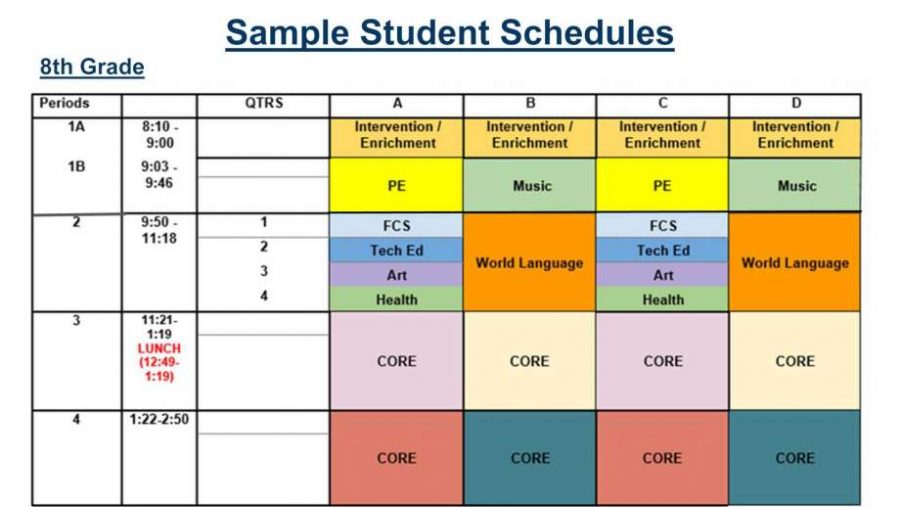The Block Schedule Debate- Students Weigh In
February 13, 2020
Block Scheduling seems to be the talk around Stamford Public Schools, and many other school districts over the last couple of years. A block schedule differs from the traditional six or seven period rotating schedule in that there are significantly longer class periods that meet fewer times each day and week. For example, Stamford High and Westhill use a seven-period schedule, and students only have six classes, dropping one each day. The local magnet high school, AITE, has adopted a block schedule. They have 8 classes in total. On A days, they have periods 1-4, and on B days, they have periods 5-8. All four of their periods are 90 minutes long. So, should SPS make the change to the Block Schedule? Two writers at The Round Table proposed their arguments on the topic.
Why Block Scheduling Is The Way To Go
The implementation of block scheduling at Stamford High School and Westhill High School has become a largely disputed issue in the Stamford Public School (SPS) system these past years. Students complain that they are already used to the current schedule, while teachers argue that they will not be able to effectively teach their curriculum. However, SPS seems to be ignoring concerns and is pushing for the new schedule to be in place for the 2020-2021 school year. Despite the opposition, I believe that SPS is making the right decision. Here’s why.
People will always be opposed to change. Teachers who have taught at SPS high schools for many years don’t want to alter their daily work schedule, while current upperclassmen don’t want to shift from something they have known for years. This opposition for the new schedule focuses too much on the negatives of the situation and seems to be more of a “follow the crowd” ordeal”. Instead, they should begin to consider the true benefits that a block schedule would have on high-schoolers.
One of the major changes to high school schedules would be the increase in the number of classes students can take. Unlike now – where students can take up to seven courses each year – block scheduling would allow students to take an extra class, bringing that number to eight.
In order to avoid forcing teachers to teach an extra class, SPS proposes a “WIN” period, during which students can take the time to complete their homework or get extra help. This period would then replace the need of a study hall in any student’s schedule, and act as a set time for students to complete school work that they struggle to find time for outside of school for (especially for those that are incredibly busy).
This increase in the number of class opportunities coincides with the new high school credit requirement that the State of Connecticut has recently put in place. The law, written under the Substitute Senate Bill No. 1059, states that “Commencing with classes graduating in [2020] 2021, and for each graduating class thereafter, no local or regional board of education shall permit any student to graduate from high school or grant a diploma to any student who has not satisfactorily completed (1) a minimum of twenty-five credits.” Prior to this, the graduation credit requirement for high-schoolers was 20.
With the current schedule, Stamford High students are able to take a maximum of 28 credit-earning classes during their four years of high school (seven classes for four years). This means that the current tenth, eleventh, and twelfth graders can fail to receive credit for eight of those classes and still graduate. In contrast, the freshmen class can only fail to get credit in three. This difference – from eight classes to three – is completely unfair for future grades. Credit can be lost to health reasons (for example, losing credit in gym because of an injury), family issues, or the taking of study halls in order to allow for ample study time. For example, a student who takes one study hall for three years and loses one half credit of gym due to a broken foot would not be allowed to graduate on time. He or she would have a total of 24.5 credits, just short of the 25.
This student could be perfectly adequate, but because of unpredictable conditions, he or she would not be able to graduate. With the new block schedule, students would be given a greater leeway and therefore increase their chances of graduation. Block scheduling increases the number of possible credits from 28 to 32, which gives current freshmen and future classes the same amount of credit “elbow room” that previous and current classes have now.
The other big change that comes with block scheduling would be the length that each class is. As of now, each regular class at Stamford High is about 55 minutes, with one “long period” that lasts about 90 minutes. With block scheduling, all classes would be 90 minutes long, with four classes each day.
One of the most frequent complaints from students and teachers is that this increase in time will result in increased distractedness and lack of productivity. However, the reality is that longer class periods help students prepare for college. The classes mimic the length of college classes, which, depending on the number of the class you take each week, can range from one to two hours. If students are having issues with their attention span, it would be better for them to get used to longer classes now instead of in college, when each credit costs hundreds of dollars.
Rebecca Johnstone, a long term substitute teacher who took the place of teacher Melissa Correa this year, has previously worked on a block schedule while at the Academy of Information Technology and Engineering (AITE). She feels that block scheduling was an overall better experience for her, compared to Stamford High’s rotating seven periods. “Instructionally, block schedules lend itself better to learning, just because of how much you’re there and how much you get to learn,” she said.
Practicing teachers are not the only ones who feel this way. Christopher Tienken, an associate professor of education administration at Seton Hall University, described short, 50 minute class periods as “a constant race against the clock.” He argues that they don’t allow teachers to allow time for independent practice, offer extra help, or deliver a “comprehensive closure” at the end of class. Furthermore, he noted that an A/B (block) schedule gives students a day break from each class, giving them time to “internalize” the information and therefore learn more efficiently.
Whether you support the new block schedule or not, it is clear that SPS needs an updated bell schedule. Other schools in the area, such as New Canaan High School and Darien High School, offer students eight periods of classes. The schedule rotates in the same way as the current Stamford High schedule does, just with shorter class periods in order to accomodate seven classes in one day instead of six. As previously mentioned, this increased number of possible credits helps students when it comes to graduation requirements.
Overall, it is time for Stamford High School and Westhill High School to consider a new daily schedule, and by the looks of SPS’s actions, that will most likely be block scheduling. If the shift is successful, students will benefit academically and be better prepared for college.
Why Block Scheduling is a Horrible Idea

Many districts and schools have switched to a block schedule while others have waited to do so. While some stand by the block schedule, many others oppose the new type of schooling, and their voices do not deserve to be silenced by the Board of Education – especially since there are multiple reasons that their concerns are valid.
First off, one common perception of the block schedule is that we get more time in our classes. This may seem true at first glance because the class periods are longer, but don’t be fooled, you only have a given class every other day. Moreover, you are in each class for less amount of time cumulatively throughout the year. It’s just common sense- you are adding one more class to the students’ schedule, but keeping the length of the school day and the school year the same. So if the focus is giving students more class time, why use this type of schedule if it actually decreases class time? This will also put pressure on achieving the curriculum. As it is now, AITE sometimes doesn’t get through the entire curriculum, often requiring the district to excuse entire sections of the district-wide finals. AP scores might go down as well.
Another focus of the block schedule is that it allows for more students to graduate because you have more opportunities to take classes. However, relaxing the graduation requirements is not what we should be doing. For the current seniors, the class of 2020, you only need 20 credits to graduate. If you take 7 classes a year for four years, you have 28 chances to get credit. That means you can fail eight classes, and still graduate. For the current sophomores and freshmen, 25 credits are needed to graduate. With this level of flexibility, you can fail three classes or take three study halls and still graduate. If we went to an eight-period schedule, you would need 25 credits out of a potential 32. The focus for our schools shouldn’t be to make it easier to graduate, rather it should be to raise the bar. Does allowing students to fail nearly two classes a year prepare them for college and the real world? As it is now, less than a third of our students are “college-ready,” meaning they have higher than 1050 on the SAT.
In addition, a frequently mentioned focus of the block schedule is a “WIN” (what I need) period. Each freshman and sophomore is required to take this WIN period, which is a class period where you can get specialized help. A student can get help from the teacher of their WIN period or can go to another teacher. Supporters of the block schedule are quite dependent on the success of this period. However, in all honesty, a WIN period is simply a glorified study hall, and if the current study hall system is broken, what makes people think a WIN period will truly be a win.
Block scheduling will also mean hiring additional teachers and paying current teachers more for teaching a sixth class as opposed to five. The estimated cost of paying teachers more and hiring 40 combined teachers at the two public high schools is over $5 million. This means cutbacks somewhere else from our already hurting school budget.
Class sizes under this system will increase too. In this case, an increase in general class sizes will most negatively impact the areas of the school that thrive with small class sizes – typically, groups like English learners and special education students.
As I spoke to teachers and students to make sense of the situation, and to clarify why we are even thinking of changing our schedule, the most popular response was “because everyone else is doing it.” However, simply because other towns are making the change doesn’t mean we need to as well. If the perks of Block Scheduling are so beneficial and obvious, then why didn’t we move to this years ago? Why wasn’t Stamford Public Schools the pioneer to move toward Block Scheduling?
Well, the reason we weren’t is that the benefits are not so obvious; rather, we are influenced and pressured by surrounding school districts. This should not be a reason to change our schedule. The last time we adopted a program due to influence from other schools was when we added Connection Time, which has not been successful at Stamford High. Why succumb to the propaganda of the state and move to a block schedule? There is no need to fix a system that is not already broken. Besides, there is a multitude of other issues that need tackling before we start with this.
I am a senior at Stamford High School and will be graduating in June. Whether or not we make the change to a block schedule doesn’t even affect me. I clearly did not raise these points because of personal distaste long class periods. I raised them to spread awareness for future students and parents. If the points in this article either strengthened your opposition to the potential scheduling or if this was the first time you heard of it, but agree with the points, please, on behalf of the future students, contact the Board of Education. The BOE shouldn’t be the deciding factor in moving to this schedule. The teachers and students, who are impacted the most by the decision, should be the people deciding. There are many students and plenty of teachers who feel the same way you do, but let’s be real – the Board of Education may not listen to the suggestions of a teacher, but they surely will listen to parents.

